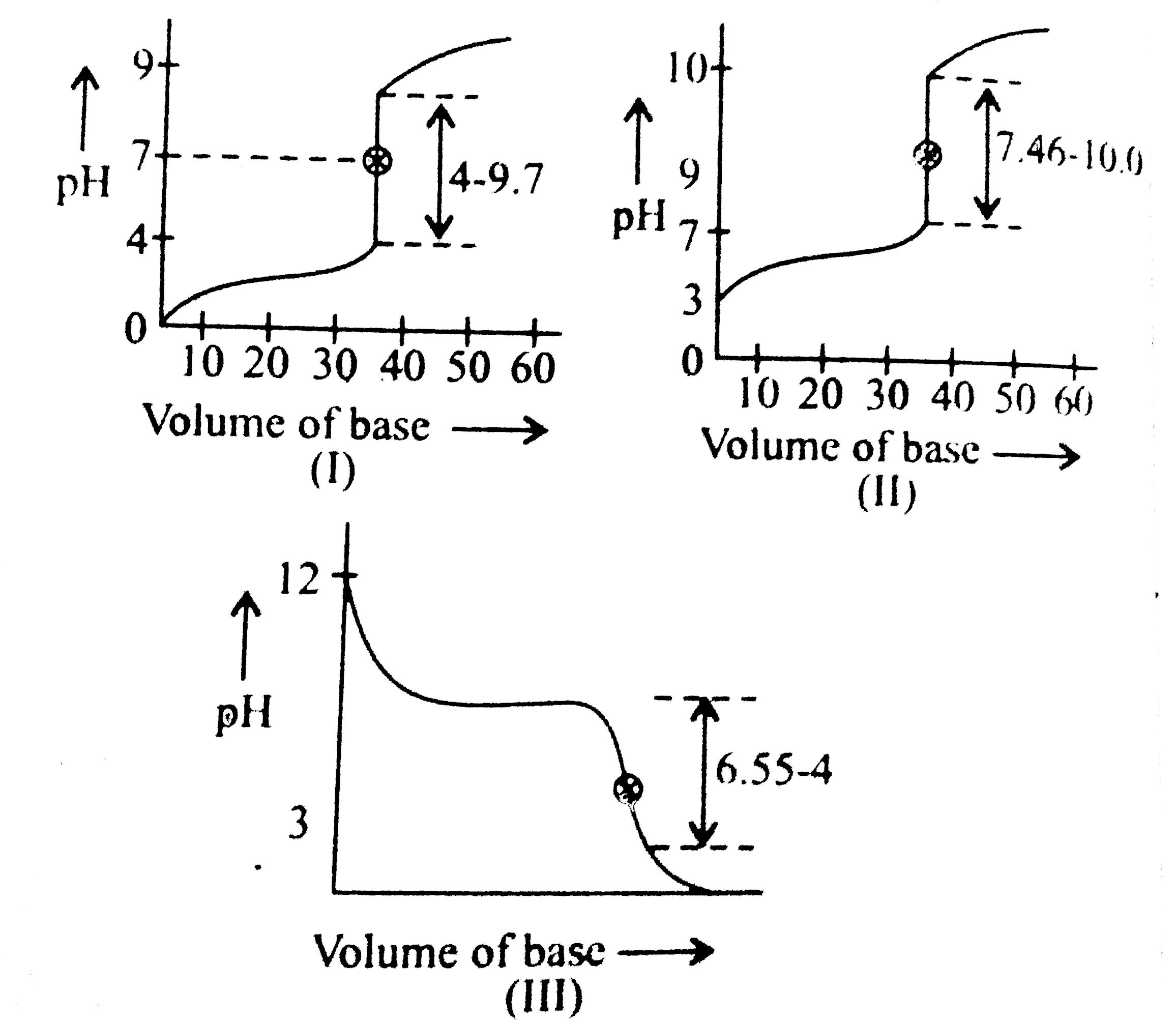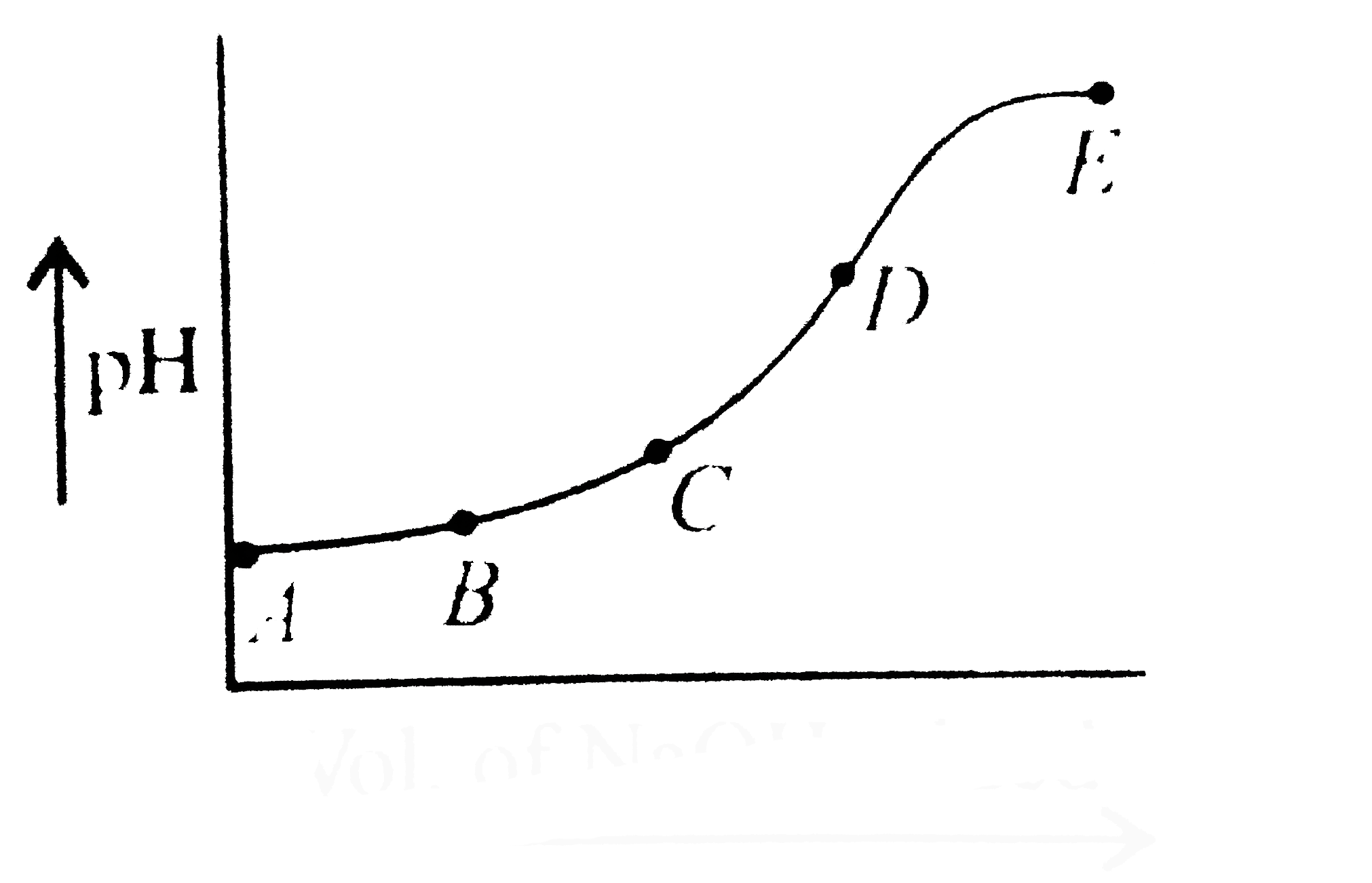Complete Solutions to Ex 8.4 of chapter IONIC EQUILIBRIUM of Class 11 book with complete answers and questions
| Class 11 | CHEMISTRY |
| Chapter | IONIC EQUILIBRIUM |
| CENGAGE CHEMISTRY | Ex 8.4 |
| Number Of Questions | 39 |
| Academic Year | 2023-24 |
a. At what `pH` does indicator change colour if the indicator is a weak acid with `K_(Ind) = 4.0 xx 10^(-4)`.
b. For which of the following neutralisation would the indicator be useful?
i. `HCl +NaOH`
ii. `CH_(3)COOH +NaOH`
iii. `HCl +NH_(3)`
c. Name the indicators which can be used for such titration.
View SolutionThe acid from of an acid base indicator is yellow in acid and red in basic from. What is the change in `pH` in order to change the indicator form `80%` yellow to `80%` red.
View SolutionGiven that solubility product of `BaSO_(4)` is `1 xx 10^(-10)` will be precipiate from when
a. Equal volumes of `2 xx 10^(-3)M BaC1_(2)` solution and `2 xx 10^(-4)M Na_(2)SO_(4)` solution, are mixed?
b. Equal volumes of `2 xx 10^(-8) M BaC1_(2)` solution and `2 xx 10^(-3)M Na_(2)SO_(4)` solution, are mixed?
c. `100mL` of `10^(-3)M BaC1_(2)`and `400mL` of `10^(-6)M Na_(2)SO_(4)` are mixed.
View SolutionThe `K_(sp)` of `AgC1` at `25^(@)C` is `1.6 xx 10^(-9)`, find the solubility of salt in `gL^(-1)` in water.
View SolutionIf solutbility of `Ca(IO_(3))_(2)` in water at `20^(@)C` is `3.9gL^(-1)`. Calculate the `K_(sp)`. Given `Mw Ca(IO_(3))_(2) = 390`.
View SolutionFind the solubility of `Ca(IO_(3))_(2)` is `molL^(-1)` in a solution containing `0.1M CaC1` at `25^(@)C`. `K_(sp)` of `Ca(IO_(3))_(2) = 6.3 xx 10^(-7)`
View SolutionThe `K_(sp)` of `BaSO_(4)` is `1.6 xx 10^(-9)`. Find the solubility of `BaSO_(4)` in `gL^(-1)` in
a. Pure water
b. `0.1M Ba(NO_(3))_(2)`
View SolutionA solution contains `1.4 xx 10^(-3)M AgNO_(3)`. What concentration of `KC1` will be required to initiate the precipitation of `AgC1 ? K_(sp) AgC1 = 2.8 xx 10^(-10)`
View SolutionIf the solubility of `CaSO_(4)` in `H_(2)O` is `10^(-5)M`, Calculate the solubility in `0.005M` solution of `H_(2)SO_(4)`.
View SolutionThe concentration of `Ag^(o+)` ions in a saturated solution of `Ag_(2)C_(2)O_(4)` is `2.0 xx 10^(-4)M`. Calculate the solubility of `Ag_(2)C_(2)O_(4)` in a solution which is `0.01M` in `H_(2)C_(2)O_(4)`.
View Solution`500mL` of `2 xx 10^(-3)M A1C1_(3)` and `500mol` of `4 xx 10^(-2)M` solution of `NaOH` are mixed and solution is diluted to `10^(-2)L` with water at room temperature wil a precipiate exist? Given:
`K_(sp)`of `A1(OH)_(3) = 5 xx 10^(-33)`.
View SolutionYou are provided with `500mL` of hard water, containing `0.005 mol` of `CaC1_(2)` and two `H_(2)SO_(4)` samples of `0.001M` and `0.02M` concentration. Which one or both or none can be used for precipitating `Ca^(2+)` ions.
`K_(sp)` of `CaSO_(4) = 2.4 xx 10^(-4)`.
View SolutionA lead salts is dissolved in `HC1` which si `95%` ionised. It is found to have `0.1M Pb^(2+)` and `0.28M H^(o+)` ions. The solution is satured with `H_(2)S(g)`. Calculate the amount of `Pb^(2+)` ions that remains unprecipitated.
`K_(sp)` of `PbS = 4 xx 10^(-29)`,
`K_(sp)` of `H_(2)S = 1.1 xx 10^(-22)`
View SolutionA solution constains `Zn^(2+)` ions and `Cu^(2+)` ions each of `0.02M`. If the solution is made `1M` in `H^(o+)`, and `H_(2)S` is passed untill the solution is satured, should a precipitate be formed? Given: `K_(sp) ZnS = 10^(-22)`,
`K_(sp) Cus = 8 xx 10^(-37)`.
In satured solution, `K_(sp) (H_(2)S) = 10^(-22)`
View SolutionThe following `pH` range where the indicator shows change in colour are given
i. `4 - 9.7` ii. `7.46-10.0` iii. `6.5-4`
Which of the above `pH` range represent titration of
I. Strong acid/strong base `(S_(A)//S_(B))`,
II. Weak acid/strong base `(W_(A)//S_(B))`,
III. Weak base/strong acid `(W_(B)//S_(A))`
View SolutionThe following acid base titration graphs are given:
(I)
Which of the following graph represents titration of
i. `NH_(4)OH//HC1(W_(A)//S_(A))`
ii. `HNO_(3)//KOH(S_(A)//S_(B))`
iii. `C_(6)H_(5)COOH//KOH(W_(A)//S_(B))`
View SolutionWhich indicator is suitable for the titrations:
`{:("Titration",,"Indicator",,),(i.HCOOH//NaOH,,(A)"Bromothymol blue or phenolphtalein or methy1 orange or thymolphthalein.",,),(ii.HBr//KOH,,(B)"Methy1 orange or methy1 red or bromocresol green",,),(ii.NH_(4)OH//NHO_(3),,(C)"Phenolphthalein or thymolphtalein",,):}`
View SolutionA solution gives the following colours with different indicators:
a. Methy`1` orange `rArr` Yellow
b. Methy`1` red `rArr` Yellow
c. Bromothymol blue `rArr` Orange
What is the `pH` of the solution?
View SolutionIn the titration of `NH_(4)OH` versus `HC1`, the `pH` of the solution at equivalence point is about:
View SolutionThe `pH` indicators are
View SolutionIn which of the following acid-base titration, the pH is greater than 8 at the equivalence point ?
View SolutionStrong acids are generally used as standard solution in acid-base titrations because:
View SolutionThe best indicator for detection of end point in titration of a weak acid and a strong base is
View SolutionThe precipitate of `CaF_(2) (K_(sp)=1.7xx10^(-10))` is obtained when equal volumes of the following are mixed
View SolutionThe solubility of `A_(2)B_(3)` is "x mol dm"^(-3)`. Its `K_(sp)` is
View SolutionThe `pH` of `Ca(OH)_(2)` is `10.6` at `25^(@)C. K_(sp)` of `Ca(OH)_(2)` is
View SolutionSolubility of `AgI` in `0.05M BaI_(2)` solution is `10^(-15)M`. The solubility of `AgI` in water is
View SolutionSolubility of a solute in water is dependent on temperature as given by
`S=Ae^(-DeltaH//RT)`, where `DeltaH`=heat of solution
`"Solute"+H_(2)O(l) hArr "Solution", DeltaH= +- x`
For given solution, variation of log S with temperature is shown graphically. Hence, solution is

View SolutionThe solubility of `CaF_(2)` in a solution of `0.1M Ca(NO_(3))_(2)` is
View SolutionThe volume of water needed to dissolve `1mg` of `PbSO_(4) (K_(sp) = 1.44 xx 10^(-8), Mw of PbSO_(4) = 303g)` at `25^(@)C` is
View SolutionThe volume of water needed to prepare a satured solution of `Ag^(o+)` having maximum `[Ag^(o+)]` ion by selecting one out of three slats form:
`AgC1(K_(sp) = 2.0 xx 10^(-10)), AgBr (K_(sp) = 5 xx 10^(-13))`, and `Ag_(2)CrO_(4)(K_(sp) = 2.4 xx 10^(-12))`. whcih compound should be used to have maximum `[Ag^(o+)]`?
View SolutionHow many grams of `KBr` can be added to `1L` of `0.12 M` solution of `AgNO_(3)` just to start the precipitation of `AgBr. (Mw "of" KBr = 120, K_(sp) of AgBr = 10^(-13))`
View SolutionThe solubility of silver benzoate `(C_(6)H_(5)COOAg)` in `H_(2)O` and in a buffer solution of `pH = 2, 3`, and `4` are `S_(1), S_(2), S_(3)` and `S_(4)` respectively. The decreasing order of solubility is
View SolutionThe solubility of `CH_(3)COOAg` in a buffer solution with `pH = 4`, whose `K_(sp) = 10^(-12)` and `K_(a) = (10^(-4))/(3)` is
View SolutionRefer to above, the ratio of solubility of `CH_(3)COOAg` in a buffer solution with `pH = 4` and in `H_(2)O` is
View SolutionWhat is the maximum molarity of `Co^(+2)` ions in `0.1M HC1` saturated with `0.1M H_(2)S. (K_(a) = 4 xx 10^(-21))`. Given: `K_(sp)` of `CoS = 2xx10^(-21)`.
View SolutionThe following curve shows the change of `pH` during the course of titration of weak acid `HA` with a strong base. At which point in the titration curve is the concentration of acid equal to that of its conjugate base.

View SolutionIf the salts `M_(2)X,QY_(2)`, and `PZ_(3)` have the same solubilities `(lt(4)/(27))`, their `K_(sp)` values are related
View SolutionArrange the following solutions in decreasing order of `[Ag^(o+)]` ion:
I. `1M [Ag(CN)_(2)]^(Theta)`
II. Saturated `AgC1`
III. `1M [Ag(NH_(3))_(2)]^(o+) in 0.1M NH_(3)`
IV. Saturated `AgI`
`(K_(sp) of AgC1 = 10^(-10), K_(sp) of AgI = 8.3 xx 10^(-17) K_(f)` (formation constant) `[Ag(CN_(2))]^(Theta) = 10^(21), K_(f) [Ag(NH_(3))_(2)]^(o+) = 10^(8)`
View Solution
Ex 8.4 questions and complete solutions for chapter IONIC EQUILIBRIUM of CENGAGE CHEMISTRY (HINGLISH) of Class 11
All Exercises from CENGAGE CHEMISTRY Class 11 CHEMISTRY IONIC EQUILIBRIUM
- Archives Fill In The Blanks
- Archives Integer
- Archives Multiple Correct
- Archives Single Correct
- Archives Subjective
- Archives True/False
- Ex 8.1
- Ex 8.2
- Ex 8.3
- Ex 8.4
- Ex 8.5
- Exercises Assertion-Reasoning
- Exercises Integer
- Exercises Linked Comprehension
- Exercises Multiple Correct
- Exercises Single Correct
- Exercises Subjective (Buffer Solutions)
- Exercises Subjective (Hydrolysis Of Salt)
- Exercises Subjective (Polyprotic Acid)
- Exercises Subjective (Weak Acid And Weak Bases)
- Exercises Subjective(Coordination Equilibria)
- Exercises True/ False
- Solved Examples